
The "cheese" word is rarely uttered when we hear about the Mediterranean Diet---yet the world's highest per-capita cheese consumption is by people who live around and within that iconic sea! Cheese and wine have been quotidian parts of their diets for millennia, and continue to be to this day. How is it that those living near the Mediterranean typically live long and healthy lives, while eating nearly twice the amount of cheese Americans do? Take this class with Maître Fromager and James Beard Award-winning author Max McCalman to learn about the role cheeses and wines play in those healthful diets. Throughout the class, you'll taste a range of cheeses and wines that represent the delicious and eye-opening evolution of Mediterranean styles.

You will work in teams to execute the class menu. At the end of class, participants gather to enjoy the food they have prepared. Wine is served with meals in most classes. All class menus are subject to change. While a snack platter is offered in both morning and evening classes, you may want to consider a light snack before joining us for class. Students are encouraged to bring a light lunch or dinner to all pastry classes.

You will work in teams to execute the class menu. At the end of class, participants gather to enjoy the food they have prepared. Wine is served with meals in most classes. All class menus are subject to change. While a snack platter is offered in both morning and evening classes, you may want to consider a light snack before joining us for class. Students are encouraged to bring a light lunch or dinner to all pastry classes.
Provence is a gastronomic paradise where French techniques meet Mediterranean elements like garlic, basil, olives, lavender and honey. Throughout this enchanting evening, you will learn essential techniques to make simple and aromatic dishes that burst with flavor. On your menu will be: brandade de morue; chicken with potatoes, rosemary, olives and lemon; bouillabaisse with rouille and vegetable tian.
What does "healthy cooking" mean, anyway? Plant-based? Macrobiotic? Low-salt? Gluten-free? Depending on whom you ask --- whether it be a nutritionist, a doctor, a chef or your mom - you will likely get different answers. While there is no single definition for what constitutes healthy eating, most people will agree that there are several key principles and dietary guidelines that will lead you toward a well-balanced diet. In this intensive series, we will explore a sensible approach to cooking and eating, using a wholesome array of ingredients. You will learn which foods you should choose on a regular basis to keep your body running smoothly, as well as those you should try to limit and why. Each day, you’ll get fully hands-on in our kitchens as you master a variety of dishes that demonstrate how you can cook healthfully, without sacrificing flavor.
These memorable but easy-to-learn dishes bring winter to the fore, using some of our favorite recipes and ingredients. They'll be the hit of any meal during the cooler days, while still tasting fresh, bright, and ideal for the moment. Everything is seasonal, and everything is delicious! You'll make and then enjoy: creamy cauliflower soup; roasted root vegetable salad with maple-mustard vinaigrette and seared duck breast with port wine reduction.
Ranked as America’s Best Culinary School (USAToday 2019), our roster of Chef-Instructors have run top kitchens around the globe.
| (Separate multiple addresses with commas like: john@aol.com, jane@aol.com) | |